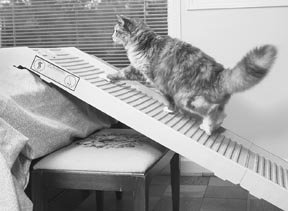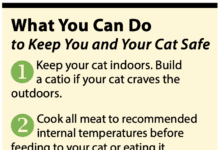Hemmies age is unknown since she was adopted as a stray, but her veterinarian estimates shes 9 or 10 years old. While she still makes the jump to the kitchen counter, it seems to take a little extra effort. Shes also a little clumsy and seems to have some sensitive spots around her elbows and lower back.
Because cats do spend so much of their time at rest, caregivers often are slow to recognize the signs of arthritis. However, if your normally agile feline fails to follow you upstairs to bed at night, its time to get her checked out by your veterinarian. Radiographs, medical history, physical exam, and blood work will help in the diagnosis.
Elizabeth Hardie, DVM, a professor in the department of clinical sciences at the college of veterinary medicine, North Carolina State University, says diagnosis is also made by viewing videos a caretaker takes of his or her cat, since cats can hide their pain and appear completely normal at the veterinarians office. In addition, she says, a short course of pain medication is given to see if the cat responds.

288
Keep your cat thin
Osteoarthritis – a degenerative joint disease – is more common in older cats. The cartilage cushioning the joints wears away. As a result, the bones start rubbing against each other, and the friction damages the bones and causes inflammation.
If your youngster shows signs of severe arthritis in many joints, Hardie notes that the kitty may have infectious arthritis or an immune-mediated arthritis, such as rheumatoid arthritis.
The best way to prevent arthritis is to keep your cat thin, says Hardie. Vitamins C and E, extra calcium, and fish oil added to your cats food might be helpful, but make sure your cats veterinarian approves. Hardie says small amounts of canned ocean fish three times a week can also be used.
Nutraceutical and drug treatments
Glucosamine-based products are often the first line of defense in treating arthritis. One such product is Co-sequin for Cats, which contains chondroitin sulfate, glucosamine hydrochloride, and manganese ascorbate. The manufacturer, Nutramax Laboratories, claims the products work together to maintain the structure of cartilage in joints while inhibiting the enzymes that break down the cartilage.
Hardies experience with Cosequin has been positive, and she now uses it before trying any other medication. The manufacturer has done the appropriate studies to show that the product contains what it claims it does and has research records to prove it works, Hardie explains.
In addition to glucosamine-based products, analgesic drugs such as steroids and opioids are used, as well as polysulphated glycosaminoglycan, which is a complex sugar. The problem for veterinarians is that safe, non-steroidal anti-inflammatory drugs for cats are still in development, says Hardie. The non steroidal anti-inflammatory drugs designed for dogs or humans are either toxic or have a very narrow margin of safety in cats, she adds. Some of them are used but very cautiously and with lots of monitoring. Acetaminophen (Tylenol) is highly toxic to cats and should never be used, while aspirin stays in cats systems longer than in humans, so it is easy to overdose.
The market is full of products that are purported to help arthritis, but Hardie cautions cat owners to use products that are marketed through veterinarians, not health food stores. Testing of over-the-counter products has indicated that many dont deliver the correct doses of the nutritional supplement.
Use of acupuncture
Acupuncture involves the stimulation of precise points on or near the surface of the body in an attempt to produce changes in the bodys internal organs and functions by using fine needles, heat, electricity, laser light, or injection.
People who utilize acupuncture for their own ailments may seek out veterinarians who can perform the procedure on their cat. In his practice, Gregory Azzolin, DVM, of Northford Veterinary Clinic in Connecticut, combines traditional veterinary medicine with acupuncture, a form of traditional Chinese medicine; he is
certified by the International Veterinary Acupuncture Society. He has treated about 10 percent of his arthritic patients with acupuncture, only four percent of which are cats.
That number is small, he says, because people dont recognize the problem given the limited movement of cats. They sleep, they go to their bowl and litter box.
Once arthritis is suspected, however, he recommends x-rays to help focus on treatment, followed by five to eight treatments on a weekly basis, reducing treatments to bi-monthly and then once a month.
So, if the exam by her veterinarian confirms that Hemmie does have arthritis, some well-chosen steps can be taken to keep her healthy and comfortable.


